Lost in Translation: Reaching Out to English-Language Learners
How do you say “Tomorrow’s assignment is . . .” in 460 languages?

The call came a week before school started. A woman from a local refugee agency told Susan Mayberger, director of English as a Second Language (ESL) programs for Omaha Public Schools, in Omaha, Nebraska, that ninety Somali Bantu students, refugees all, would arrive in a several days.
"We weren't prepared," says Mayberger, whose programs serve 6,000 ESL learners, about 89 percent of them Spanish speakers. Not surprisingly, adds Mayberger, "we had no one on staff who spoke Somali."
Already struggling with meager federal budget allotments for ESL students, Mayberger scrambled, using money from a refugee grant to hire a local interpreter to translate for the families. Meantime, her teachers used the Internet to learn more about Somalia. Many of the soon-to-arrive teens had never held a pencil or a book, Mayberger says. Others' parents had been killed.
"Some had had horrendous experiences," she says, adding that her expectations, particularly for the older children, have had to be humble. "My goal is to give them enough English to get a job, to survive."
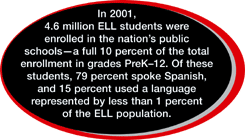
Habla Ingles?
The influx of English-language learners (ELLs) into communities across America has created new and unprecedented challenges for administrators and teachers, many already struggling with overcrowded classrooms, dwindling budgets, and strict performance standards for their students. Waves of immigration once limited to large cities such as New York, Miami, and Los Angeles are now reaching into the nation's suburbs, its largest Southern cities, and pockets of the heartland, bringing with them children whose needs go beyond language to issues of poverty and lack of stability, often associated with minimum wage or migratory employment.
Yet even as educators acknowledge the need to better accommodate ELL students in the nation's classrooms, a contentious debate over how to best educate these students has grown, and this political battle is far from over. In addition, as the pros and cons of bilingual education versus English-language immersion are researched and reviewed, current and prospective teachers get few opportunities to train in either approach before facing classes full of kids who don't understand what the adults in front of their classrooms are saying. (See "No Train, No Gain.")
Fortunately, some districts and individual schools have found ways to grapple successfully with multilingual classrooms, using techniques that range from extending the school year and adding after-school programs to implementing scripted phonics-based learning programs. Other schools have tapped community resources -- and not just for educational support.
At Kreitner Elementary School, in Collinsville, Illinois, half the students are native Spanish speakers learning English, and many cope with financial disadvantages at home. Kreitner's principal, David Stroot, found that his initial calls for professional support, back in 2001, fell flat because of a lack of funding and a shortage of bilingual teachers, so he found volunteers from a local community college to help with onsite translation. For books in Spanish, Stroot turned to the local city library. For hats, coats, and gloves for children arriving from warmer climates, he appealed to community organizations.
"We are still on the second step of a twenty-step ladder," he says, more than five years after he arrived at Kreitner. "We are now only starting to make an impact."
The number of ELL students enrolled in public school has nearly tripled since 1993, from about 2 million to 5.5 million today, according to the U.S. Department of Education. Brown University's Educational Alliance reports that about 44 percent of that population is concentrated in rural communities, where bilingual teachers are hardest to find. The bulk of these children attend elementary school, and more than half live in western states such as California and Arizona, often in the poorest border towns.
All told, fifteen states have reported an increase in ELL students of more than 200 percent over the past three years. The boom is most pronounced in Southern states such as Arkansas, Georgia, South Carolina, Tennessee, and North Carolina, which has had the fastest growth of students with limited English proficiency. Kentucky saw its number of ELL students triple in five years, triggering a need for federal emergency grants that increased from $158,000 in 1998 to $622,000 in 2002, still far less than what the state says it needs.
The children of political exiles and war refugees represent a large swath of English learners, among them Cambodians, Hmong, Sudanese, and Vietnamese. Schools in Randolph, Massachusetts, a Boston suburb, have more than fifty Haitian-Creole speakers in their classrooms, while one of the largest populations of Hmong refugees, who immigrated from Laos after the Vietnam War, live and go to school in Fresno, California. Native speakers of Cantonese, Korean, and Russian also can be found in the nation's classrooms, where Spanish speakers still represent a huge majority -- 80 percent of all public-school ELL students. In all, about one in five students in public schools lives in a home where English is not the primary language, and more than 460 languages are represented in the nation's classrooms.
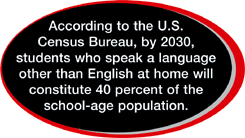
Economic Hiccup, Population Shift
At the same time they struggle with a language barrier, most ELL students must cope with income and achievement gaps. According to a study by the Urban Institute's Immigration Studies Program, limited English skills are highly correlated with poverty and other measures of hardship. In addition, concludes the diversity advocacy group California Tomorrow, more than half of immigrant students eventually show patterns of failure: The longer they have been in the United States, say researchers, the lower their grade-point averages, the more limited their life and career aspirations, and the higher their dropout rate.
Because population shifts can be tied to economic hiccups at home or political events halfway around the globe, inundations of ELL students often take school districts by surprise. Yet even where such increases are steady and predictable, the experience can overwhelm teachers. In California, a state with historically high levels of ELL students, 14 percent of teachers aren't fully credentialed, and a quarter of ELL teachers aren't fully certified for the specialty, according to a study sponsored by the University of California. Molly Ness, author of Lessons to Learn: Voices from the Front Lines of Teach for America, taught a class of forty-three kids -- speaking ten languages -- during her first year as a teacher at Roosevelt Middle School, in Oakland, California. She says she was completely unprepared to deal with the experience. "Our training of teachers needs to change," she says.
In fact, bilingual and ESL training aren't usually part of typical undergraduate teaching-degree programs. In Texas, for instance, where the number of ELL students doubled between 1990 and 2002, just 17 of 169 universities that offer teaching degrees have either ESL or bilingual teaching programs -- and the teachers who do study methods taught in these curricula often don't move to areas where they are sorely needed, says Mike Holt, director of Texas A&M University's Office of P-16 Initiatives.
About 73 percent of urban school districts have an immediate need for bilingual teachers, according to the Washington, DC-based Council of the Great City Schools. This dearth of qualified instructors has led to stiff hiring competition among needy districts. California, Georgia, and Texas recruit bilingual teachers directly from Mexico. Elsewhere, signing bonuses for teachers who speak both Spanish and English are not uncommon: The Los Angeles Unified School District has offered bonuses of up to $5,000; and in Texas, the Galena Park district offers $3,000, while the Dublin district offers $2,000. School districts in Dallas and Houston pay $36,000-$41,000 annually to teachers in "high-needs" fields, including bilingual education, compared to the standard salary of $28,000.
Pressured by neighboring school districts, Dodge City, Kansas, now offers a $1,000 signing bonus to bilingual teachers. "We are out there scratching as much as anyone else," says Robert Vinton, director of ESL and migrant education for the city's public schools, where 49 percent of all students are Spanish speakers learning English. Less than 10 percent of the district's 300 teachers are bilingual.
In many states, better training for teachers arrives only after schools are overwhelmed with ELL students. Joy McLaughlin was brought into the Asheboro, North Carolina, public schools four years ago to help train teachers in ESL after the Spanish speaking population began to rise. About 18 percent of the Asheboro's district's 4,000 students are learning English and, although the state doesn't require it, McLaughlin, director of the district's limited-English-proficiency (LEP) program, takes two or three teacher volunteers from each school and provides forty hours of training over the course of a year.
The strategy is working, McLaughlin says. "Children who exit the ESL program are outperforming regular students" on state-mandated tests, she adds.
It is often the specter of standardized tests that strikes fear into the hearts of many teachers with large populations of ELL students in their classrooms. Under the No Child Left Behind Act (NCLB), passed in 2002, public schools have until 2014 to show adequate yearly progress for all students in math and English. Districts that fail to make the required amount of progress are subject to sanctions, no matter how many students are unfamiliar with the language of the tests. Teachers of ELL children argue that these students are tested prematurely, especially when little in the way of federal funding or support exists to prepare them for the experience.
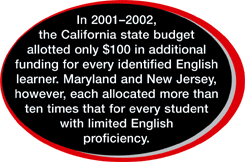
Bilingual Battles
But teachers also disagree about the most effective approach to teaching English learners. Some educators still favor bilingual education, which requires teaching core subjects in students' native tongues while they learn English. That approach is losing momentum, however, as more schools choose to maintain English-only classrooms. At this point, about 75 percent of public schools with LEP students provide ESL programs, compared to 36 percent for bilingual programs. (One-third of schools with ELL students use both approaches, hence the total of more than 100 percent.)
Proponents of English immersion cite developments in California and Arizona as proof of their argument. Both states, which effectively ended most bilingual education with propositions passed in recent years, lifted test scores under the NCLB this year. "The main problem with children in bilingual programs is that they didn't learn English," says Rosalie Porter, former director of bilingual and ESL programs for the Newton Public Schools, in Newton, Massachusetts, and an advocate of Proposition 227 in California (and one of its drafters), which gave the English-only movement a boost. "They were segregated. It took forever to convince educators that we were not doing the job for the kids."
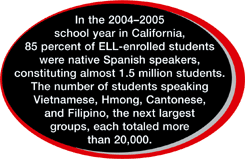
Those who champion bilingual programs argue that focusing on English, while losing ground in other subjects, is a long-term disaster for many students. "We should not simply throw those native language skills away in our haste to educate the kids," says James Crawford, executive director of the National Association for Bilingual Education. "Bilingual education is much more effective than throwing kids into a sink-or-swim or English-only program."
But an increased emphasis on testing has pushed teachers such as Christine Ramos, who teaches first grade at Murphy Elementary School, on Chicago's North Side, to teach more in English, even though she believes ELL students fare best when they are taught in their native tongue. "You're always conflicted in bilingual education" between balancing English with a student's native language, she says. Though students at her school spend three years in a bilingual program before moving to a mainstream classroom, she believes many would gain a deeper comprehension of English if they learned slowly over four to seven years.
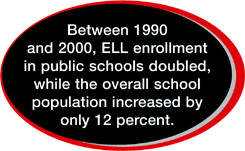
Challenges and Solutions
No matter what approach they choose to teach English learners, school districts have had to be creative, finding ways to adapt programs to unique budget and training challenges. Many are finding that local experiments in ELL instruction are paying off.
At El Mirage Elementary School, in El Mirage, Arizona, test scores showed progress this year, an indication that English learners are improving their skills. In part, the school credits the phonics-based Success for All learning program, which requires all teachers to follow a strict, uniform lesson plan and all students to practice reading in class for ninety minutes each day and at home for twenty minutes each night. Kids who can't read get tutored individually.
"It's scripted and easy to follow," says El Mirage Principal Joel Davidson. "But it's got to be monitored and followed through carefully." Teachers at the school also break students into small groups based on ability, provide individual tutoring, and encourage cooperative learning.
By the end of last year, 41 percent of the school's students were reading at grade level, up nearly threefold from 2003. Still, the school again failed to meet Arizona's Instrument to Measure Standards this year and had to submit a plan to improve its scores over the next several years. "The school is making slow and steady progress, but we've got a long way to go yet," Davidson says.
The Postville Community School District, in Postville, Iowa, has an ELL population that includes Kurds, Russians, Ukrainians, and students from various Asian countries, as well as Spanish speakers, who make up 16 percent of the total student population. District schools offer individual after-school assistance to struggling students, and Superintendent David Strudthoff has implemented an optional 200-day school year. Half of the district's K-8 students have taken advantage of the extended instruction, and their test scores are showing signs of improvement.
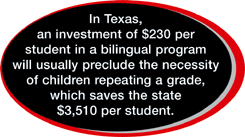
"Now, 80 percent of the district's fourth graders are proficient readers, and 76 percent are proficient in math,"he says. "We are 10 percent above what state wants under No Child Left Behind." Still,the superintendent adds,the older ELL students who arrive in the district at middle school and high school age are struggling. "With a fourteen- or fifteen-year-old, it's very hard to see them through," he says.
For Collinsville's Stroot, success with ELL students is an ongoing community effort. "There's a lot of stress," he says. "But we keep getting more assistance from people who speak Spanish." His sixth-grade alumni who have mastered English are now starting to help out as interpreters for new families, Stroot adds, and teachers from Puerto Rico, through word of mouth, are applying for jobs at the school.
"Teachers who speak English only have more to deal with here," says Paola Meyer, who teaches a bilingual kindergarten class of twenty-three kids in Collinsville, half of them ELL students. A native of the Dominican Republic, Meyer says she mastered English as a child by taking special classes on Saturdays. "I went through the struggle."
"Children can learn," adds Stroot. "We just have to find ways to go ahead and get it done."
Kim Girard is a writer based in San Francisco.
ELL, FYI
If you have not taught ELL students before, following are some suggested resources to help guide your way:
- Visit Web sites such as these for information on how to handle issues you may confront: Working With English Language Learners: Strategies for Elementary and Middle School Teachers, Focus on Effectiveness: Current Education Challenges, and ORTESOL (Oregon Teachers of English to Speakers of Other Languages.
- Join a professional organization. Teachers of English to Speakers of Other Languages (TESOL) offers a wealth of conferences, workshops, and grants, plus ideas for ELL teachers.
- Subscribe to the ELL Outlook, a bimonthly online newsletter that provides ideas, stories, and inspiration for ELL teachers.
- Join an online forum, such as Using English.com or Aardvark's English Forum.com, where you can ask for advice and share tips with other ELL teachers of varying experience levels.
- Download ideas and exercises from Boggle's World, a Web site featuring free worksheets, flash cards, and classroom-exercise downloads that combine a fun approach with activities to help students learn vital English skills.
- Assess the situation by finding out how much English your students already know. The LAS Links system, by McGraw-Hill, offers guidelines for using test results to hone your teaching skills.
- Translate new words and concepts into visual representations. Download graphics and pictures from EnchantedLearning.com, for example, or encourage students to create their own, and check out the National Geographic Society, which publishes visual textbooks. You can also visit onestopenglish and the Visual Thesaurus.
- Invest in tools that make learning fun. LeapFrog's new Fly pen allows students to hear their own handwritten English translated into Spanish. The gadget interacts with what the user writes, so students will stay engaged with their learning.
- Consider your options. Some students will ultimately learn English better if they have some instruction in their native language along the way. The new "Todos a leer con PLATO Achieve Now" package, from Plato Learning, is designed to further learners' Spanish reading skills while helping them acquire oral English ability.
- Encourage independence among older children. High school students may benefit from interactive English packages such as Rosetta Stone, which they can use at home to increase their daily exposure to English.